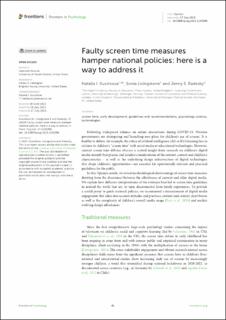| dc.contributor.author | Kucirkova, Natalia | |
| dc.contributor.author | Livingstone, Sonia | |
| dc.contributor.author | Radesky, Jenny | |
| dc.date.accessioned | 2024-02-02T15:09:48Z | |
| dc.date.available | 2024-02-02T15:09:48Z | |
| dc.date.created | 2023-08-02T10:54:09Z | |
| dc.date.issued | 2023 | |
| dc.identifier.citation | Kucirkova, N., Livingstone, S. & Radesky, J. (2023) Faulty screen time measures hamper national policies: here is a way to address it. Frontiers in Psychology, 14 | en_US |
| dc.identifier.issn | 1664-1078 | |
| dc.identifier.uri | https://hdl.handle.net/11250/3115356 | |
| dc.description.abstract | Following widespread reliance on online interactions during COVID-19, Western governments are strategizing and launching new plans for children's use of screens. It is healthy to debate, for example, the ethics of artificial intelligence (AI) or K12 learning loss in relation to children's “screen time” with social media or educational technologies. However, current screen time debates obscure a central insight from research on children's digital media: namely that precise and detailed considerations of the content, context and children's characteristics - as well as the underlying design infrastructure of digital technologies that shape children's opportunities—are essential for operationally relevant and practical guidelines for the public.
In this Opinion article, we reveal methodological shortcomings of screen time measures deriving from the disconnect between the affordances of current and older digital media. We explain how different interpretations of the evidence base led to screen time guidelines in around the world that are, in turn, disconnected from family experiences. To provide a useful proxy to guide national policies, we recommend a measurement of digital media engagement that takes into account attitudes and practices; content and context; short bursts as well as the complexity of children's overall media usage (Barr et al., 2020) and media's evolving design affordances. | en_US |
| dc.language.iso | eng | en_US |
| dc.publisher | Frontiers Media S.A | en_US |
| dc.rights | Navngivelse 4.0 Internasjonal | * |
| dc.rights.uri | http://creativecommons.org/licenses/by/4.0/deed.no | * |
| dc.subject | skjermtid | en_US |
| dc.title | Faulty screen time measures hamper national policies: here is a way to address it | en_US |
| dc.type | Peer reviewed | en_US |
| dc.type | Journal article | en_US |
| dc.description.version | publishedVersion | en_US |
| dc.rights.holder | © 2023 The Author(s). | en_US |
| dc.subject.nsi | VDP::Samfunnsvitenskap: 200::Pedagogiske fag: 280 | en_US |
| dc.source.volume | 14 | en_US |
| dc.source.journal | Frontiers in Psychology | en_US |
| dc.identifier.doi | 10.3389/fpsyg.2023.1243396 | |
| dc.identifier.cristin | 2164440 | |
| dc.relation.project | Norges forskningsråd: 314117 | en_US |
| dc.relation.project | Jacobs Foundation: PR-10919 | en_US |
| dc.relation.project | Norges forskningsråd: 275576 | en_US |
| cristin.ispublished | true | |
| cristin.fulltext | original | |
| cristin.qualitycode | 1 | |

